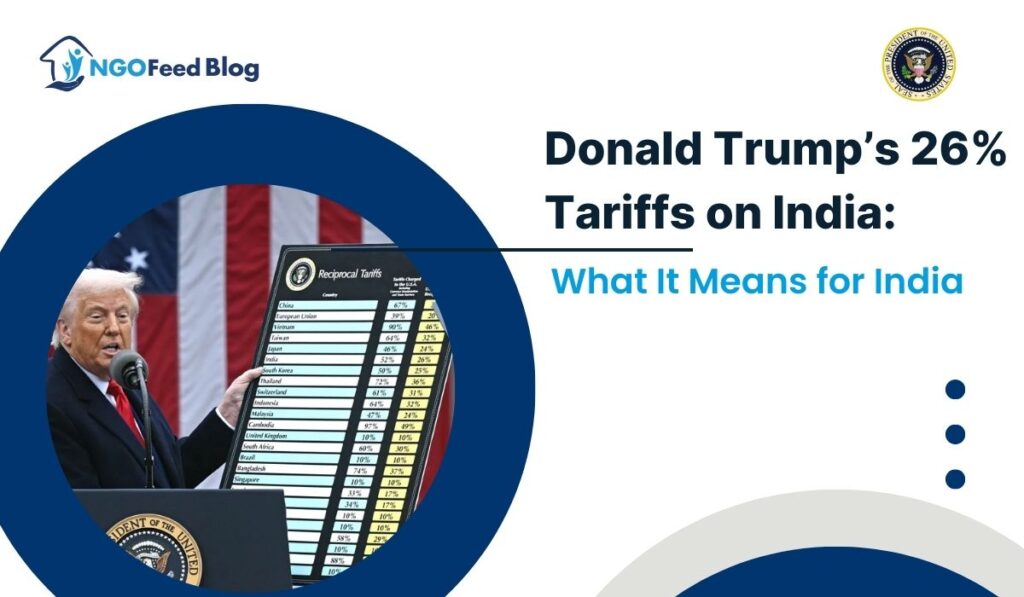Donald Trump 26% Tariffs on India: President Donald Trump announced through his April 2, 2025 speech that U.S. trade policy would include a 10% import duty for all products beginning April 5, 2025. The White House followed recent changes by identifying India as a country that needed a 26% tariff increase after evaluations which had brought down the initial 27% trade barrier.
Several economic and strategic factors as well as political elements will emerge through the implementation of U.S. trade restrictions on India. Here’s a breakdown:
Table of Contents
1. Economic Impact
Indian exports to the U.S. market will become less competitive due to elevated tariff rates therefore decreasing American demand for these goods. Manufacturers in textile production and steel industries together with agricultural providers and IT service organizations would experience the strongest effects.
The rise in Indian export costs would likely drive up the prices American shoppers pay for imported merchandise thus generating buyer inflation on some particular products.
The expansion of Indian suppliers’ costs triggers businesses to search for alternative suppliers or raises product prices for their consumers.
2. Impact on Key Sectors
The IT and Tech sector of India may encounter decreasing customer demand which will result in revenue consequences. However the companies need to redirect their attention toward different geographic markets to cope with this financial loss.
Indian farmers and manufacturers and their workers would experience economic damage because of agricultural product and textile tariff implementations.
3. Political and Diplomatic Consequences
The implementation of trade limitations will create diplomatic tension between the United States and India which consequently endangers their combined cooperation in military defense together with climate change measures and worldwide security initiatives.
The negative impact could worsen through India imposing trade restrictions on United States products which might activate international trade conflicts.
4. Long-Term Strategic Shifts
India will probably step up its initiative to spread its export market bases and lower its U.S. market dependence speeds.
The global market pressure will likely encourage India to conduct reforms and make investments which strengthen its domestic industries.
5. Global Ripple Effects
Impact on Global Trade: Since both nations are global economic powers, their trade tensions might have implications for global markets, including supply chains and international trade agreements.
Impact on Other Key Sectors:
- The increase of 26% duty on diamond exports from Surat causes a major crisis that threatens jobs in that region together with decreased export levels.
- The export market for textiles together with agriculture is likely to experience lower U.S. demand which will impact their revenue and employment levels.
- The pharmaceutical industry maintains its entry into the U.S. market since it holds an exemption from these imposed tariffs.
India’s Response to Donald Trump’s 26% Tariffs
The Indian government evaluates current developments to create strategies that will decrease the adverse effects on businesses under strain. Indian officials engage in dialogue to establish trade agreements while seeking alternative measures that reduce the negative impact caused by these tariffs.
Presidential leader Donald Trump introduced a 27% reciprocal tariff against Indian imports on April 3rd, 2025 as part of his efforts to fight Indian trade barriers towards U.S. exports. The Indian government through its Commerce and Trade Ministry announced its examination of this new tariff effects while meeting with U.S. trade representatives to work on the issue. This policy transformation will receive analysis from the ministry for potential business prospects it may provide.
India has chosen a diplomatic route instead of swift retaliation after the imposed tariff because it has maintained a businesslike approach. The trade agreement process between India and the U.S. continues while the countries work together to address present trade differences as well as develop bilateral economic opportunities.
The introduction of this new tariff led to swift economic effects immediately after its announcement. April 4, 2025 marked a decline in Indian stock market performance as both the Nifty 50 fell by 1.17% and the BSE Sensex dropped 0.97%. U.S. tariffs introduced new fears of currency recession throughout the world leading to market dip.
India examines the effects of U.S. tariffs but concentrates on diplomatic actions to solve the trade problems through negotiation to develop favourable trade terms.
Future Impacts of Donald Trump 26% Tariffs on India
The U.S. tariffs on India may generate numerous effects that will affect domestic economic sectors as well as international political relations during the upcoming period. Here are some potential scenarios:
1. Economic Impact
- Bilateral trade faces disruption because of these tariffs which mainly affects significant sectors such as IT together with textiles and pharmaceuticals and agriculture products.
- The need for risk reduction could push organizations to spread their supply chains across different markets thus generating advantages for rising economies.
- Inflationary forces may emerge in India when import prices rise thereby affecting ordinary consumers.
2. Business and Investment
- U.S. business interest in Indian investment opportunities could decrease but other global corporations might seize emerging business opportunities in this changing environment.
- The Government of India should direct more efforts towards improving its trading connections with major economic powers including the EU and Japan and ASEAN countries.
3. Diplomatic Relations
- The imposition of tariffs will likely damage the diplomatic connection between India and the United States by impairing their bilateral work on defence operations and technological and climate-change partnerships.
- India will work to obtain better conditions through existing and forthcoming trade deals both with the United States and other global partners.
4. Sector-Specific Effects
- The cost of contracts for U.S. technology firms who use Indian IT services could increase which might cause them to reduce their outsourcing activities.
- Indian farmers along with exporters will face difficulties gaining market access to U.S. territories thus reducing market possibilities for exported fruits and various agricultural products.
5. Long-Term Strategic Shifts
- The “Make in India” program should receive enhanced support from India to avoid dependency on foreign imports while growing its national manufacturing sector.
- The imposed tariffs would produce global trade pattern transformations that will affect how countries maintain economic relationships and finalize trade agreements with each other.
Why is it a matter of concern?
Several essential reasons exist about U.S. imposed tariffs on Indian imports because they create economic stress and political tension and strategic complications.
1. Economic Growth and Trade Balance
- The U.S. tariffs imposed on Indian products will decrease export demand because American consumers and enterprises will pay elevated prices.
- A decrease in exports will result in a deteriorating trade deficit which puts India at risk for economic instability.
- The textile sector and agricultural sector as well as IT services industries which export significant portions to the U.S. may reduce their workforce numbers and decrease employee pay.
2. Global Supply Chains
- The operations of numerous multinationals utilizing smooth international trade principles through their supply chains would face major disruption. These chains will encounter interruptions from tariffs which leads to elevated costs together with operational inefficiencies.
- The shift of business supply chains to different nations would diminish India’s position as a primary global supplier.
3. Diplomatic Tensions
Bilateral diplomatic ties become damaged when tariffs are imposed because it hampers international cooperation across critical areas including national defense along with counter-terrorism and climate change and technological innovation.
Protectionist measures implemented by the U.S. likely will motivate other nations to establish same policies which may produce a fragmented international market design.
4. Inflation and Cost of Living
- Tariffs on imported products create increased consumer expenses through rising essential item costs that obstruct the purchasing power and purchasing capacity of society.
- The cost of required materials and components from the U.S. increases production expenses thus hurting business profitability for Indian businesses.
5. Investor Confidence
- Changes in market stability become common after tariff implementations which leads to instability across financial markets while turning away foreign-direct investments through decreased investor confidence.
- Trade policy unpredictability creates challenges for businesses to execute long-term planning due to the resulting uncertainty.
6. Strategic Autonomy
- Over-Reliance on U.S. Markets: The tariffs underscore the dangers of dependence on one market. India would have to diversify its markets for exports and deepen economic connections with other countries.
- In fact, tariffs are not merely an economic matter—they may transform India’s place in the world, determine its domestic policy, and affect millions of people through employment, prices, and foreign policy changes.
Role of NGOs in Donald Trump 26% Tariffs on India
Non-Governmental Organizations (NGOs) have extensive power to influence policy decisions that include introducing trade barriers through tariffs. NGOs do not hold legislative authority of their own but they influence decisions through:
NGOs influence policy changes through two methods: first they actively communicate with policymakers while they create campaigns to activate public support and second they advocate for definite outcomes. NGOs in India will push or fight against tariffs to achieve their organizational goals which might include economic justice together with environmental protection and labor rights.
NGOs increase public support by educating communities about tariff effects on agricultural, technological and manufacturing sectors thus building government-level pressure to change their position.
The advocacy work of NGOs frequently results in studies and report publications alongside expert analysis meant to influence tariff-related discussions. These economic assessment insights help policymakers understand all the social, environmental and economic effects that result from their choices.
Some NGOs build connections with international partners to create unified groups that use pressure from outside nations. The organization should collaborate with various NGOs such as Indian activists along with international rights advocates and global trading communities to demonstrate how U.S. imposed trade barriers affect India on multiple international platforms.
NGOs working for social justice and poverty relief purposes demonstrate how trade policies affecting vulnerable groups shapes ethical decisions related to trade policies.



